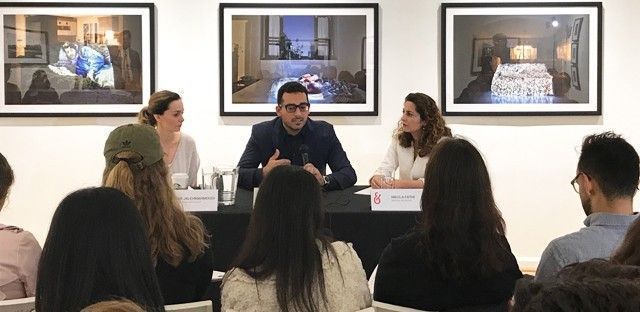By Tara Biglari
Works by 10 Iranian artists are headlining at the Hillyer Art Space in a quaint neighborhood of downtown Washington, D.C. The exhibition, curated by photographer and video artist Gohar Dashti, represents each artist’s perspective on the public versus the private space, and provides a commentary on the everyday experience of life in Iran.
Upon entering the gallery, the viewer is immediately drawn to the works of Saba Alizadeh. In a series called ‘Light and Soil,’ the artist has photographed projections of war images on pieces of furniture inside meticulously tidy middle-class living rooms. The images show a dead soldier, troops walking in a straight line, and guns being lifted in the air. They convey how pervasive war has been in the lives of ordinary Iranians, and how difficult it is to separate the public from the private realm.

“I find it interesting to see younger generations using war symbols to talk about Iranian society, the values that they see, things that have shaped them,” said author Nazila Fathi, a former New York Times correspondent in Tehran, and moderator for a panel discussion organized around the exhibition, ‘Art in Context: Iran.’
Alizadeh’s war photographs of the 1980-88 Iran-Iraq war inspired much discussion. “The impact of the Iran-Iraq war is the reason we work around themes of identity. This social situation was so normalized in Iran; this was the only childhood we knew,” said artist Bahar Jalehmahmoudi, another panelist.
Other works in the exhibition illustrate the impact of the 1979 Islamic Revolution. Rana Javadi‘s photographs show the tensions in Iran in the 1970s through symbolic representations of fists in the air and tanks in the street.
Commenting on the restrictions to individual freedoms that followed the revolution, Fathi explained: “Part of the reason people started painting and playing music was because there wasn’t much else to do.”
“People found a way to reinvent themselves with an Iranian identity, so they turned to the past,” she added.
For Jelahmahmoudi, studying art was the only way she knew to stay true to herself. It was “in itself a statement, a form of rebellion” against the internal dynamics of life under the new theocracy, she said.
Notions of freedom are also addressed in artist Hamed Noori’s video installation. By overlaying an image of Tehran with footage of rough seas, the artist appears to indicate that despite the challenges of everyday life in Iran, the hardships and restrictions will not last forever.

Arash Fayez’s video of himself shaving his beard in California shows the struggle to integrate in the West. Behnam Sadighi’s black-and-white photographs of urban decay in Iran highlight the struggle to find happiness.
Another panelist, installation artist and sculptor, and Founder and President of the Aftab Committee, Shahrooz Shekraubi, noted the restrictions that came with bringing Iranian art to the U.S.
He added: “Right now, there’s a tendency to place Iranian artists into boxes. It’s important to think about and consider them as individuals rather than Iranians.”
The talk was held as part of the International Arts & Artists (IA&A) International Partnership Initiative, launched in 2013 to foster constructive conversations between leaders in art, academia, and politics across the globe.
The Urban Mapping exhibition is on until October 29th: more information here. The other artists represented at the exhibition are: Raoof Dashti, Ghazaleh Hedayat, Mehran Mohajer, Siavash Naghshbandi and Mehdi Vosoughnia.

